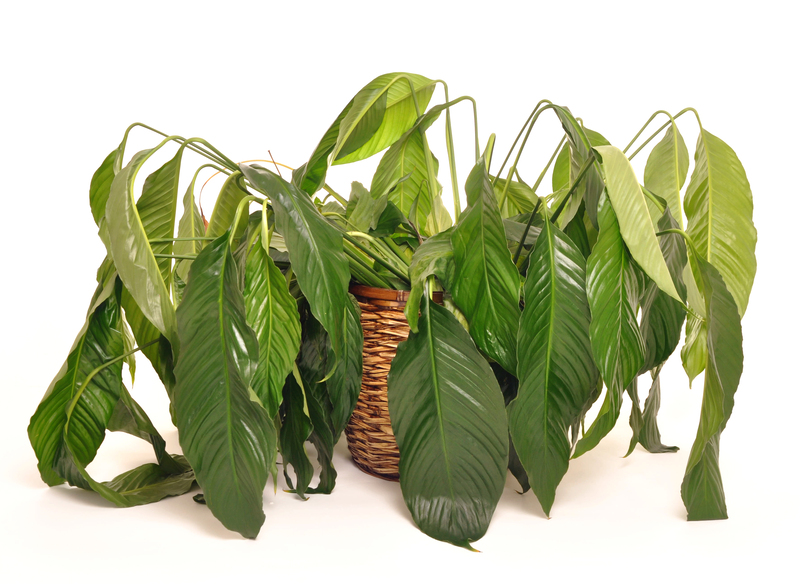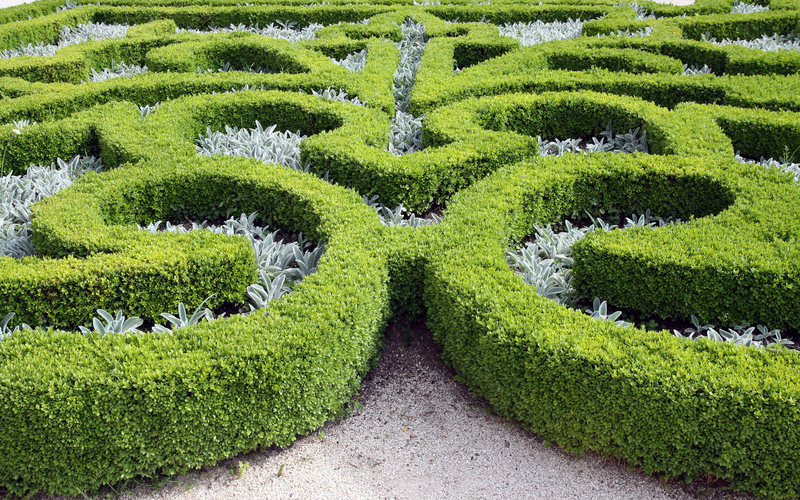Vertical Gardening Techniques for Every Space
Posted on 22/08/2025
Vertical Gardening Techniques for Every Space: A Complete Guide
Looking for innovative gardening solutions that maximize limited space, beautify your environment, and deliver fresh produce or flowers? Vertical gardening techniques offer a creative and sustainable way to bring greenery into any setting--whether you live in a compact apartment, own a modest backyard, or want to transform your office. In this comprehensive article, you'll discover vertical gardening ideas, step-by-step guides, plant choices, DIY projects, and expert tips for building your own lush vertical oasis anywhere.

What Is Vertical Gardening?
At its core, vertical gardening is the practice of growing plants upward instead of outward, utilizing walls, trellises, shelves, or modular frameworks. Unlike traditional gardening, which consumes horizontal space, vertical garden projects take advantage of vertical surfaces, making them ideal for urban dwellings, patios, balconies, and even indoor spaces.
Why Choose Vertical Gardening?
- Space Efficiency - Perfect for small and awkward areas
- Aesthetic Appeal - Adds modern, lush beauty to dull walls
- Better Air Quality - Indoor vertical gardens help purify the air
- Ergonomics - Easier to plant, prune, and harvest
- Pest and Disease Reduction - Improved air circulation lowers risk
By incorporating vertical garden techniques into your living space, you can enjoy gardening all year round--no matter how small your environment is.
Types of Vertical Gardening Systems
Before you pick up your shovel, it's important to understand the various vertical gardening systems available. Choosing the right setup depends on your available space, budget, and plants you wish to grow.
1. Trellises and Obelisks
Trellises and obelisks are classic supports for climbing plants like beans, peas, and flowering vines. They are easy to install, affordable, and available in wood, metal, or plastic.
- Best for: Garden beds, patios, balconies
- Plants: Clematis, roses, sweet peas, cucumbers
2. Living Walls (Green Walls)
Living walls are visually stunning and highly customizable. They use vertical modules or panels filled with soil, hydroponics, or felt pockets to house a variety of plants. Living walls are ideal for both indoor and outdoor spaces.
- Best for: Office lobbies, apartments, patios, urban areas
- Plants: Ferns, philodendrons, succulents, herbs
3. Hanging Gardens
If you have ceiling space, why not grow a garden above eye level? Hanging gardens use suspended pots, woven baskets, or upcycled containers to create a cascading effect.
- Best for: Balconies, porches, windowsills
- Plants: Trailing vines, strawberries, spider plants
4. Vertical Planters & Pocket Planters
Vertical planters are stackable pots, wall-mounted pockets, or shelving systems that allow you to grow a variety of plants securely anchored to a wall or fence. Many garden supply stores offer modular vertical garden kits to simplify setup.
- Best for: Fences, homes, offices, entranceways
- Plants: Lettuce, mint, petunias, small vegetables
5. Pallet Gardens
Upcycle old shipping pallets into stunning, rustic vertical gardens! Simply attach landscape fabric, fill with soil, and arrange your plants between pallet slats.
- Best for: DIYers, inexpensive makeshift gardens
- Plants: Herbs, succulents, salad greens
Best Vertical Gardening Techniques for Small Spaces
Even a narrow strip of wall or a tiny balcony can become a flourishing vertical garden. Here are some of the most effective techniques tailored to urban dwellers and renters:
Use Over-the-Door and Wall-Mounted Pocket Planters
- Install a breathable pocket planter on a sunny wall. Fill the pockets with herbs, trailing flowers, or compact vegetables.
- Perfect indoor vertical garden option for apartments. Keep near kitchen for easy access to fresh herbs!
Repurpose Old Items
- Transform shoe organizers, bookshelves, or wooden crates into quirky, functional vertical planting spaces.
- Punch drainage holes and add lightweight soil for best results.
Suspend Pots and Baskets
- Hang clusters of lightweight pots from a rail, balcony, or ceiling beam.
- Group by plant type for stunning color and texture contrast.
Create a Kitchen Herb Wall
- Mount mason jars or small pots on a wooden board or specialized rack.
- Fill with basil, thyme, oregano, parsley for an edible, fragrant vertical garden!
Vertical Gardening Techniques for Balconies & Patios
Outdoor areas such as balconies and patios are prime locations for vertical gardens. They often receive ample sunlight and can support larger or heavier structures.
Install a Modular Green Wall System
- Pick a modular living wall kit that suits your space and sunlight availability.
- Securely anchor to fencing or a sturdy wall, following manufacturer's instructions.
- Plant with a mixture of climbers, leafy greens, and edible flowers.
DIY Pallet Garden for Patios
- Find a clean, untreated wooden pallet.
- Attach landscaping fabric to the back and bottom to hold soil in place.
- Stand pallet upright, fill with loose potting mix, and tuck in herbs, small veggies, or annuals between slats.
- Water regularly and watch your vertical edible garden thrive!
Shelf-Style Vertical Planters
- Install narrow shelves above one another on any sunny fence or wall.
- Place pots of varying heights for depth and dimension.
- Rotate seasonal plants for year-round interest.
Grow Up with Trellises
- Choose tall planters or pots and anchor trellises in them for mobile vertical gardens.
- Grow sweet peas, beans, cucumbers, or ornamental vines to add privacy and lushness.
Vertical Garden Techniques for Indoor Spaces
Indoor vertical gardens, also known as living green walls, can transform any room. They act as natural art pieces, boost well-being, and help filter indoor air. Here are popular vertical planting methods for interior spaces:
Hanging Pocket Organizers
- Mount a multi-pocket felt or canvas organizer in bright indirect light.
- Grow air-purifying houseplants like pothos, ferns, or heart-leaf philodendrons.
- Easy to water and maintain; switch out plants seasonally.
Wall-Mounted Hydroponic Gardens
- Hydroponic systems grow plants without soil, using nutrient-rich water.
- Ideal for kitchens or living rooms; integrate LED grow lights for low-light areas.
- Grow leafy greens, cherry tomatoes, or microgreens all year round.
Stacked Shelving and Floating Pots
- Install wall shelves or brackets to support a variety of small potted plants.
- Create a modern, minimalist look with uniform pots or mix for a bohemian twist.
DIY Vertical Garden Ideas and Projects
Getting started with DIY vertical gardening is fun and affordable. Here are some creative projects that require only minimal materials and simple tools:
1. Ladder Plant Stand
- Repurpose an old wooden ladder as a multi-level plant stand. Place pots on each rung, using trailing or upright plants for drama.
2. PVC Pipe Wall Planter
- Cut PVC pipes into halves or segments, drill drainage holes, and mount horizontally on a sunny wall.
- Perfect for growing lettuces, spinach, or succulents in rows.
3. Gutter Gardens
- Attach old rain gutters to fences or walls at staggered heights.
- Fill with shallow-rooted crops such as strawberries, lettuce, or alpine herbs.
4. Upcycled Bottle Gardens
- Hang plastic bottles, cut in half, in rows on a fence or wall.
- Plant colorful annuals or fresh kitchen greens for a sustainable vertical garden display.
Choosing the Right Plants for Your Vertical Garden
Selecting the correct plants is crucial for success with vertical gardens. Some species thrive better than others in upright environments. Consider these factors:
- Light Requirements: Match your plant choices to available sunlight.
- Root Depth: Shallow-rooted plants are ideal for pocket planters and shallow shelves.
- Watering Needs: Group plants with similar watering preferences together.
- Growth Habits: Use climbers and trailers for trellises; compact, upright growers for pocket planters.
Top Plants for Vertical Gardening
- Herbs: Basil, mint, oregano, parsley, thyme, sage
- Leafy Greens: Lettuce, spinach, arugula, kale, Swiss chard
- Vegetables: Cherry tomatoes, radishes, chili peppers, beans, peas
- Flowers: Petunias, nasturtiums, pansies, impatiens, fuchsias
- Succulents and Air Plants: Echeveria, sedum, tillandsia
- Houseplants: Pothos, philodendron, spider plants, ferns, peace lily
Vertical Gardening Care and Maintenance Tips
While vertical gardens are low-maintenance, they do require proper care to thrive. Follow these practices for a flourishing vertical space garden:
- Watering: Vertical gardens tend to dry out faster. Install drip irrigation or use self-watering planters for convenience.
- Fertilization: Feed lightly every 2-4 weeks during growing season with a balanced, water-soluble fertilizer.
- Pruning and Deadheading: Remove faded blooms and trim back overgrowth for healthy, bushy plants.
- Pest Monitoring: Check leaves and soil for pests; use natural controls when possible.
- Light Monitoring: Rotate and move containers as needed to ensure even light exposure.
- Soil Replacement: Refresh soil or growing medium each season for best results.
Expert Tips for Successful Vertical Gardens
- Start Simple: Try a small project first--such as a hanging herb rack--to build confidence before scaling up.
- Mix & Match: Combine different vertical methods (living wall + trellis) for diversity and resilience.
- Optimize Microclimates: Pay attention to light, wind, and humidity. Adjust plant placement to suit microclimates in your space.
- Innovate: Vertical gardens are highly customizable. Experiment with edibles, ornamentals, aromatics, or even moss for a unique statement piece.
- Engage the Senses: Use fragrant plants and those with textured foliage for a multi-sensory experience.

Sustainable and Eco-Friendly Vertical Gardening
Eco-conscious gardeners will appreciate that vertical gardening is inherently sustainable. By using vertical space, you can:
- Reduce water waste--drip irrigation systems use less water efficiently.
- Recycle old materials--upcycle wood, bottles, and containers for planters.
- Grow your own food--cut food miles, eat healthy, and reduce packaging waste.
- Create urban habitats--attract birds, pollinators, and beneficial insects.
- Improve insulation--vertical gardens on exterior walls can help with energy efficiency.
Conclusion: Embrace Vertical Gardening in Every Space
No matter the size or shape of your space, vertical gardening techniques can transform any wall, fence, or corner into a lush, productive green zone. From modular living walls and clever DIY projects to hanging gardens and repurposed pallets, the possibilities are endless. Whether you're dreaming of a kitchen herb garden, a privacy screen of blooms, or a striking succulent wall, vertical gardening offers beauty, efficiency, and sustainability for every lifestyle.
Ready to start your own vertical gardening adventure? Gather your materials, choose your plants, and watch as your space turns into a vibrant living canvas. With the right care and a little creativity, your vertical garden will thrive and inspire for years to come.

